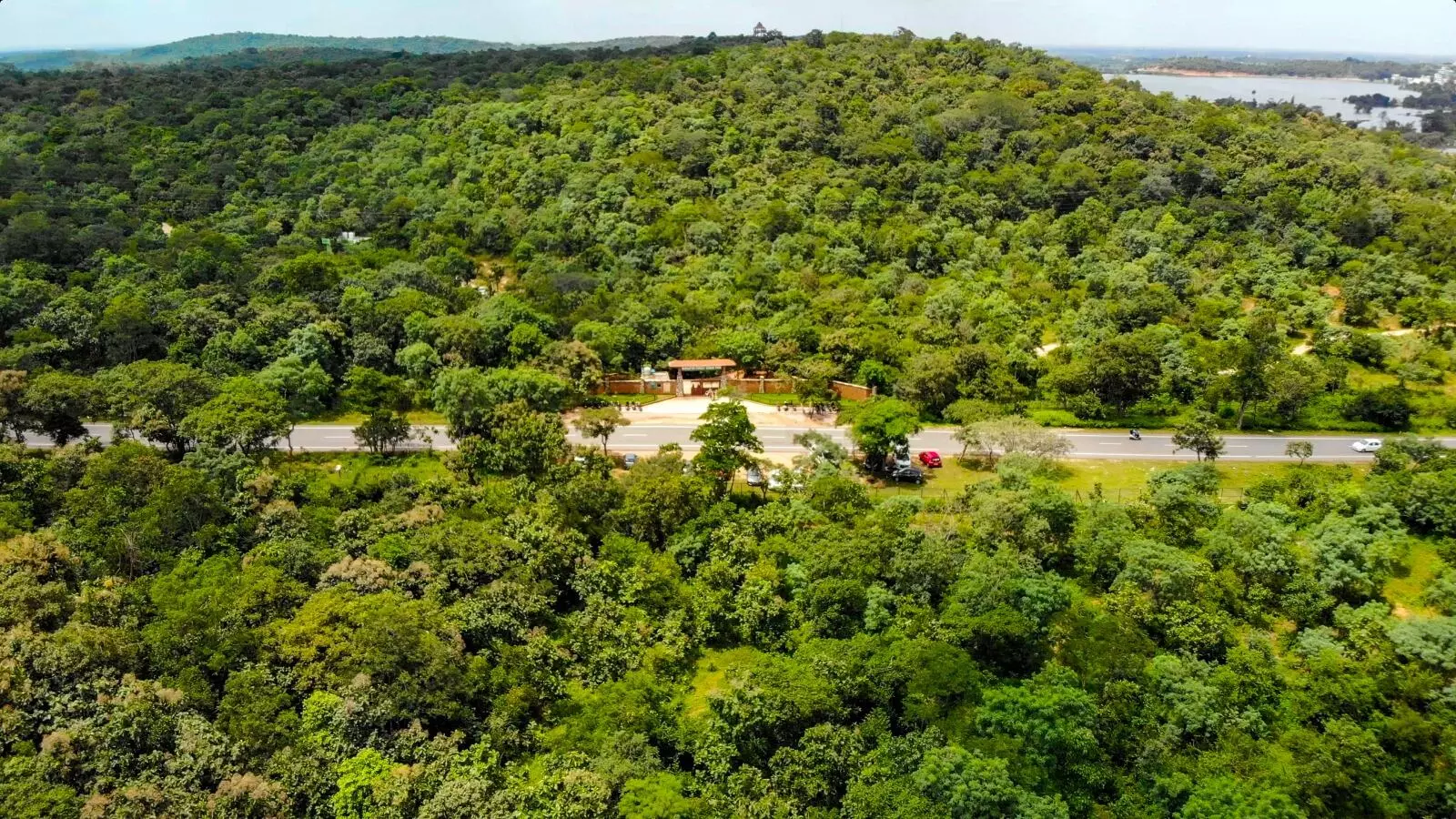Telangana Goes Green: HMDA plants 1.9 lakh saplings, 126 trees in a day for Haritha Haram
Dry and brown lands of Telangana have given way to a lush green paradise, making it one of the greenest states in the country.
By Nikisha Uddagiri
Telangana: In a remarkable transformation, dry and brown lands of Telangana have given way to a lush green paradise, making it one of the greenest states in the country. As part of the decennial celebrations of Telangana state formation day, the government marked June 19 as Telangana Harithotsavam. The Hyderabad Metropolitan Development Authority (HMDA) planted 1.9 lakh saplings and 126 trees in a single day as part of their green initiatives.
The HMDA officials planted a 15-foot-high banyan tree at Kotwal Guda Eco Park. Additionally, 126 trees of the Banyan and Ravi species were translocated to the park. Over 200 HMDA and HGCL employees planted 15,000 saplings at Kotwal Guda Eco Park, while another 25,000 saplings were planted at Eliminatedu Forest Urban Forest block.
Furthermore, 1,50,000 saplings were distributed for free through mobile vehicles at various centres along the Outer Ring Road (ORR) and Twin Cities.
Overall, a total of 1,90,000 saplings and 126 banyan trees were planted under the supervision of HMDA Urban Forest management. Several high officials and employees, including Metropolitan Commissioner Arvid Kumar, participated in the Kotwal Guda Eco Park planting event.
Green History
This ceremony coincides with Phase 9 of the Haritha Haram program, which aims to plant a staggering 19.29 crore saplings along canals and irrigation projects this year.
Launched in 2015 by Chief Minister K Chandrashekar Rao, the program seeks to achieve a 33% green cover, promoting sustainable development and preserving the environment for future generations. Telangana ku Haritha Haram is inspired by green initiatives in China and Brazil and is one of the largest endeavours to enhance greenery, benefiting livelihoods and increasing rainfall.
Telangana Harithotsavam celebrations feature the state’s commitment to sustainable development and environmental conservation, with plantation programs beginning in Thummaluru to vibrant festivities at Ravindra Bharathi, Hyderabad on Monday evening.
Progress in going green
According to the Forest Survey of India’s 2021 report, Telangana witnessed a remarkable increase of 7.7% in its green cover. Over the past decade, the state government invested a staggering Rs 10,822 crores towards the effective implementation of the Haritha Haram program. As a result of this extensive effort, 273 crore saplings are planted across the state, rejuvenating 13.44 lakh acres of forest lands and completing plantations in 2.03 lakh acres. Within the forest limits, 24 crore saplings are planted.
The green budget (Haritanidhi)
The Telangana Government implemented a unique initiative called the Green Budget (Haritanidhi), allocating 10% of the budget to protect the environmental balance and increase greenery. The active participation of people, employees, and voluntary organisations is instrumental in the success of the program. As a result, the green cover of the state increased by 7.7%.
Hyderabad’s parks flourish
Within the bustling metropolitan area of Hyderabad, the Greater Hyderabad Municipal Corporation (GHMC) developed an impressive 977 parks as part of the Haritha Haram program. Collaborations with voluntary organisations and colony societies enabled the GHMC to plant nearly 10 crore saplings, nearing their target. The successful preservation of these plants by Nati showcases the program’s accomplishments.
Nurseries, parks, and Avenue plantation
The Haritha Haram program witnessed the establishment of 14,864 nurseries across the state, contributing to the successful plantation of saplings. Additionally, 19,472 Palle Prakruthi Vanams covering 13,657 acres and 2,011 Bruhat Palle Prakruthi Vanams in 6,298 acres are developed. Extensive focus is given to avenue plantations on roadsides and in the middle of roads, covering over 12,000 km across Telangana.
Urban parks and forests for recreation and green spaces
To provide recreational facilities and green spaces for urban areas, the Telangana government developed green lung spaces as urban forest parks on the outskirts of cities and towns. About 109 urban parks are developed, covering approximately 75,740 acres, to cater to the needs of the urban population. Within the Greater Hyderabad Municipal Corporation (GHMC) limits, 164 Haritha Vanams are developed, raising 1.06 crore saplings in 1.71 lakh acres.
Expanding forest zones and urban forestry
In response to Hyderabad’s expansion, the Telangana government is actively developing forest zones around the city, spanning an area of 50-60 km and covering over one and a half lakh acres of forest land. These forest zones safeguard the city’s surroundings and promote healthy air quality. Furthermore, the urban forestry initiative along the Musi Riverfront creates a thriving urban green space.
Converting empty spaces into dense forests
Using the Akira Miyawaki technique, Hyderabad is proactively transforming empty spaces into vibrant, dense forests. Notable companies such as NTPC, GenQ, Exgon, and CGI are actively contributing to this initiative as part of their Corporate Social Responsibility (CSR) commitments.
Hyderabad’s path to becoming an industrial pollution-free city
The Telangana government devised plans to make Hyderabad an industrial pollution-free city by identifying and relocating 1,545 polluting industries beyond the Outer Ring Road. Additionally, 19 dedicated industrial townships are established to facilitate this transition and promote a cleaner, healthier urban environment.
Medicinal forests to foster urban biodiversity
The Urban Biodiversity Department of the GHMC is spearheading the establishment of two medicinal forests in urban areas. These gardens raise awareness about the benefits and various uses of medicinal plants among the populace, promoting urban biodiversity and enhancing the well-being of residents.